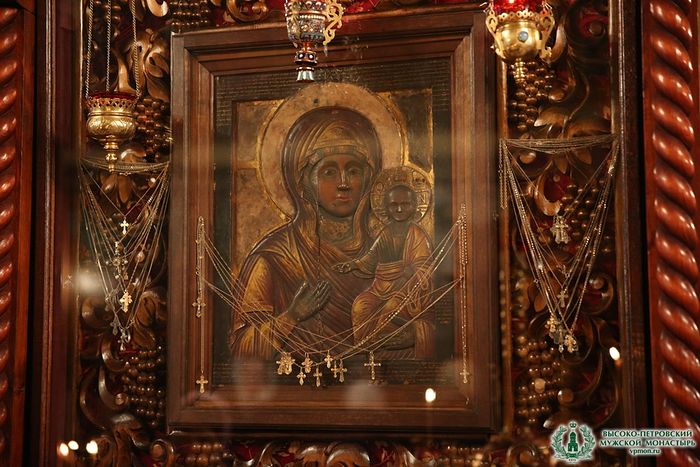Moscow, July 22, 2016
From the eighteenth to the early twentieth century one of three ancient copies of the Blachernae wonderworking icon of the Mother of God was kept at the St. Sergius Church of Moscow Novopetrovsky Monastery. The copy, which was created by orders of Tsar Peter I the Great in 1701, is currently kept at the Church of the Nativity of the Mother of God in Staroye Simonovo (Moscow). With the blessing of His Holiness Patriarch Kirill of Moscow and All Russia the icon will be returned to Vysokopetrovsky Monastery soon, reports the website of the Moscow Diocese.
The size and iconography of this copy are similar to those of the original icon. The icon was painted with the use of the unique “wax and mastic” technique: thin coats of paint over a layer of wax, covering etched wooden figures of the Mother of God and the Baby Christ. The wax and mastic is “a mixture of holy relics and many other fragrant materials,” which makes it a distinctive reliquary.
“It is not painted, but looks physical or as if it was made of mastic, for its body parts relief out from the surface of the board to great amazement of observers, filling them with awe… It looks embodied.” This is how the writer, Archdeacon Paul of Aleppo, described the miracle-working icon in his memoirs (of both the historical and ethnographical significance) after his travels around Russia in the mid-seventeenth century.
The icon was kept at the St. Sergius Church of Vysokopetrovsky Monastery until it was closed in 1918. During the Soviet era the icon was kept in a storeroom of the State Historical Museum. Two other venerated copies of the Blachernae icon are presently kept at the Tretyakov Gallery (earlier at the Princes Stroganov-Golytsin family estate in the Vlakhernskoye village (Kuzminki), and at the Central Andrei Rublev Museum of Early Russian Art).
According to tradition, the Blachernae icon of the Mother of God was originally painted by St. Luke the Evangelist and was famous for numerous miracles. Afterwards it was brought from Jerusalem to Constantinople by Empress Pulcheria and placed at the church in Blachernae, a suburb of the western section of Constantinople. Providentially, after the fall of the Eastern Roman (or Byzantine) Empire and the capture of Constantinople by the Turks in 1453, the icon moved from the Second Rome of Constantinople to the Third Rome of Moscow, where it survives to this day intact. At the present time it is kept at the museums of the Moscow Kremlin.

